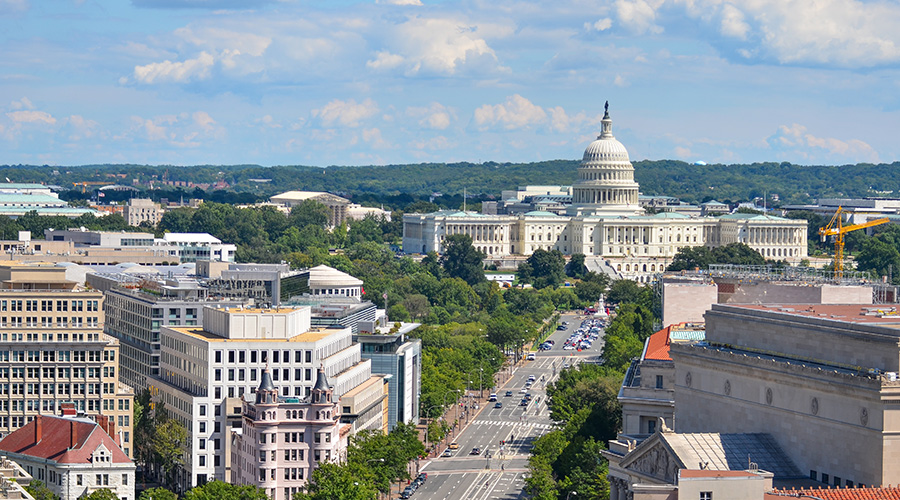Mandate for Zero Emissions in Federal Buildings
Mandate for Zero Emissions in Federal Buildings - Facility Management Energy Efficiency Quick Read FacilitiesNet


The U.S. DOE Implements Rule to Phase Out Fossil Fuel Use in Federal Buildings

The U.S. Department of Energy recently announced that it has fulfilled the Congressional mandate to reduce emissions from new and newly renovated federal buildings. This achievement is in line with the Clean Energy for New Federal Buildings and Major Renovations of Federal Buildings Rule, which implements the Energy Independence and Security Act (EISA) of 2007. The rule requires federal agencies to gradually eliminate the use of fossil fuels in new federal building construction or major renovation projects.
Under this rule, federal agencies must achieve a 90 percent reduction in fossil fuel use for any new projects initiated between fiscal years 2025 and 2029. The ultimate goal is to completely eliminate the use of fossil fuels in new projects by 2030. By implementing this rule, along with Executive Order 14057 and other actions outlined in the Federal Sustainability plan, the U.S. is making significant progress towards achieving net-zero emissions by 2045.
The U.S. DOE estimates that over the next 30 years, this rule will result in a decrease of two million metric tons of carbon emissions and 16,000 tons of methane emissions from federal buildings. To ensure compliance with the rule, the DOE’s Federal Energy Management Program (FEMP) will issue supplemental guidelines and provide support to agencies through resources, grant funding opportunities, training, and technical assistance.
Sustainable Development Goals (SDGs)
- Goal 7: Affordable and Clean Energy
- Goal 11: Sustainable Cities and Communities
- Goal 13: Climate Action
Conclusion
The U.S. DOE’s implementation of the Clean Energy for New Federal Buildings and Major Renovations of Federal Buildings Rule is a significant step towards achieving the Sustainable Development Goals. By phasing out fossil fuel use in federal buildings, the U.S. is contributing to the global efforts to combat climate change and promote sustainable development.
SDGs, Targets, and Indicators
| SDGs | Targets | Indicators |
|---|---|---|
| SDG 7: Affordable and Clean Energy | Target 7.2: Increase substantially the share of renewable energy in the global energy mix | No specific indicators mentioned in the article |
| SDG 9: Industry, Innovation, and Infrastructure | Target 9.4: Upgrade infrastructure and retrofit industries to make them sustainable, with increased resource-use efficiency and greater adoption of clean and environmentally sound technologies and industrial processes | No specific indicators mentioned in the article |
| SDG 11: Sustainable Cities and Communities | Target 11.3: Enhance inclusive and sustainable urbanization and capacity for participatory, integrated, and sustainable human settlement planning and management in all countries | No specific indicators mentioned in the article |
| SDG 13: Climate Action | Target 13.2: Integrate climate change measures into national policies, strategies, and planning | No specific indicators mentioned in the article |
| SDG 15: Life on Land | Target 15.2: Promote the implementation of sustainable management of all types of forests, halt deforestation, restore degraded forests, and substantially increase afforestation and reforestation globally | No specific indicators mentioned in the article |
1. Which SDGs are addressed or connected to the issues highlighted in the article?
- SDG 7: Affordable and Clean Energy
- SDG 9: Industry, Innovation, and Infrastructure
- SDG 11: Sustainable Cities and Communities
- SDG 13: Climate Action
- SDG 15: Life on Land
The issues highlighted in the article are connected to these SDGs because they involve the transition to clean energy, sustainable infrastructure, sustainable urbanization, climate action, and the promotion of sustainable land management.
2. What specific targets under those SDGs can be identified based on the article’s content?
- Target 7.2: Increase substantially the share of renewable energy in the global energy mix
- Target 9.4: Upgrade infrastructure and retrofit industries to make them sustainable, with increased resource-use efficiency and greater adoption of clean and environmentally sound technologies and industrial processes
- Target 11.3: Enhance inclusive and sustainable urbanization and capacity for participatory, integrated, and sustainable human settlement planning and management in all countries
- Target 13.2: Integrate climate change measures into national policies, strategies, and planning
- Target 15.2: Promote the implementation of sustainable management of all types of forests, halt deforestation, restore degraded forests, and substantially increase afforestation and reforestation globally
These targets are relevant to the issues discussed in the article as they focus on increasing renewable energy use, upgrading infrastructure for sustainability, promoting sustainable urbanization, integrating climate change measures into policies, and implementing sustainable land management practices.
3. Are there any indicators mentioned or implied in the article that can be used to measure progress towards the identified targets?
No specific indicators are mentioned or implied in the article that can be used to measure progress towards the identified targets. The article mainly discusses the implementation of a rule and the estimated decrease in carbon and methane emissions from federal buildings.
Copyright: Dive into this article, curated with care by SDG Investors Inc. Our advanced AI technology searches through vast amounts of data to spotlight how we are all moving forward with the Sustainable Development Goals. While we own the rights to this content, we invite you to share it to help spread knowledge and spark action on the SDGs.
Fuente: facilitiesnet.com

Join us, as fellow seekers of change, on a transformative journey at https://sdgtalks.ai/welcome, where you can become a member and actively contribute to shaping a brighter future.







